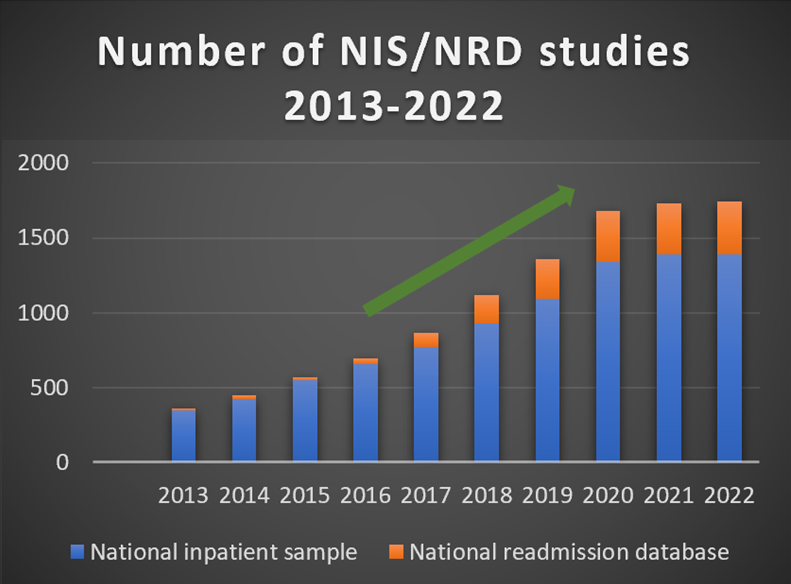Using National Databases for Research: The Good and the Bad
The NIS and NRD offer convenient data sources for fellows starting out in research—just don’t overlook other opportunities.

Last year during the TCT meeting, I was waiting to present a project that our team performed to study the impact of mental health disorders on the outcomes of patients admitted for cardiac disease. The moderator introduced me by saying: “So, here is another NIS study.”

My presentation went well, but afterwards, the moderator’s choice of words stuck with me. Was my work just “another” study?
I’ve used Healthcare Cost and Utilization Project (HCUP) databases like the National Inpatient Sample (NIS) and Nationwide Readmissions Database (NRD) for the last 6 years. Over time, it’s true, there has been a steady rise in the number of projects using these resources. Just take a look at the rows of posters at major cardiology conferences, or a search through PubMed, and you’ll see the evidence. But is this a bad thing?
What Are HCUP Studies?
HCUP comprises the largest collection of longitudinal care data in the United States, including information on healthcare use, access, outcomes, and costs related to hospital inpatient stays, ambulatory surgery and services, emergency department visits, and readmissions. Within the field of internal medicine research, and cardiology in particular, NIS and NRD are used most commonly.
What Explains the Increasing Use?
The number of studies using NIS and NRD data has been on the rise over the past decade. I’d argue that they offer several advantages which might explain the trend:
- Access: Getting access to good research opportunities is challenging, particularly for foreign medical graduates who often match at community programs where institutional projects might be more limited than they would be at large academic centers. The NIS and NRD databases are readily and publicly available. The patient information is deidentified, thus exempting the studies from the IRB process. This opens up a lot of time and energy for the research team, which can be spent on other aspects of the research process.
- Macro trend tracking: These databases can be used to study trends in diseases, procedures, or complications as well diseases or procedures with a relatively low incidence, because the data are captured on a nationwide basis, thus yielding a larger sample to study. For similar reasons, HCUP data are immensely valuable for studying healthcare resource utilization on a national scale.
 Opportunity to collaborate: Since these databases are government compiled, the research team can include a collaboration between multiple members at different levels of experience from various institutions. This can help to bring in different perspectives and provides an excellent opportunity to garner mentorship, which is helpful in the residency and fellowship match process.
Opportunity to collaborate: Since these databases are government compiled, the research team can include a collaboration between multiple members at different levels of experience from various institutions. This can help to bring in different perspectives and provides an excellent opportunity to garner mentorship, which is helpful in the residency and fellowship match process.
Still, a Flip Side
But no resource is perfect, and there are two main pitfalls that I have observed in using HCUP data.
- Lack of granularity: These databases are missing information on clinical data points like vital signs, medication use, and diagnostic studies. Given the absence of these features, it is difficult to determine the rationale behind a given clinical decision. This means the research questions posed in HCUP studies must be tailored carefully to factor in this shortcoming.
- Too convenient: Research demands patience. From framing the idea to IRB submission, data collection, data analysis, manuscript drafting, submissions, and revisions, one project can take months to years to complete. The comfort of skipping a few of these steps by using HCUP data can easily lead a young researcher to gravitate toward NIS/NRD studies over time. They can almost feel like the fast food of research, if you will—very easy to get your hands on, but not necessarily fulfilling. Limiting your time and focus to these resources could mean missing out on the opportunities to be involved in other prospective and retrospective studies that would afford richer researcher experiences.
Ultimately, NIS/NRD studies can be a powerful introduction to the field of clinical research and offer the opportunity to learn more about methodology and biostatistics. They can also be incredibly helpful for studying specific kinds of research questions, especially if the researcher keeps in mind the potential drawbacks associated with using them. If balanced well with other types of research projects, these studies can be a valuable addition to a medical trainee’s profile, especially in the early stages of training.
Tushar Mishra, MD, is a second-year general cardiology fellow at Wayne State University/Detroit Medical Center in Detroit. Raised in India…
Read Full Bio



Comments